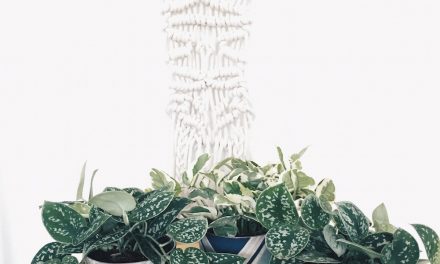Put a Plant on It | Clean Air, Easy Care: Pretty, Tough Houseplants that Purify
I feel like a squatter in any space until my plants are nestled within the walls. Wonders of both form and function, these botanical babies light up a home in a way that no electrical mechanism can. They bring spirit and vivacity. They cleanse and charm. They yield restorative magic. Because of their unique capability to beautify and vitalize, I consider houseplants a must-have.
Flora is inherently therapeutic. When we bring the outdoors in, physical and mental (and I dare say emotional) health benefits result. Proximity to plants fortifies health and expedites healing. How? Consider the biology: during photosynthesis plants consume atmospheric carbon dioxide and respire life-giving oxygen. They excel at phytoremediation – the detoxification of our environment. Roots and leaves gobble up trace contaminants from our air, reduce the amount of airborne dust and increase interior humidity. Plants literally fight indoor air pollution (which is often worse than the contaminated air outside).
Rumor has it, the positive influences of the plant kingdom don’t stop with purifying air and boosting physical health; the mere presence of plants in an interior environment has been shown to reduce anxiety and improve mood, concentration, memory retention and productivity. Even more fascinating is the finding that people who maintain a proximity to plants express greater compassion, empathy, generosity and trust in social relationships. Don’t believe me just yet? Take a look at some of these scientific studies on the many numerous benefits of being around plant life: NASA pt. 1 + NASA pt. 2 + SCIENCE DAILY.
While it’s clear that plants elevate our quality of life, few use them abundantly. Perhaps this is due to the “trouble” with plants: you have to care for them, or you will lose them. Isn’t that true of most (all) things that matter in life? Here I attempt to convince you that the output of beauty and well-being from plants is completely worthy of the necessary input—the time and energy to care for your green creatures. I also fully recognize these precious things — time and energy — are in short supply for most of us in our busy lives. Taking that into consideration, this series was designed to help you maximize your efforts. We will focus on plants that do a lot for us yet require little in return. These plants can handle a little slack, like irregular watering, dry climates, cold temps or super low light. On a whole, they are, frankly, hard to kill. The chore of bringing the outdoors in can be lessened by choosing the right organisms. I hope the hearty plants introduced in this small series inspire you to level up and bring in the green.
Now…onto practical matters.
PLANTERS:
Where will you house these tough greens that you now so desire?
In my utopia, each and every green gem would reside in a container hand-crafted by one of my favorite ceramics artists. But, as Lulu mentions in her recent blog post – Put a Plant On It, purchasing everything from a local ceramicist could get mighty pricey. Don’t go for broke. If this is out of your budget (as it often is for me), or you just don’t have access to a nearby potter, you can always hit up your neighborhood thrift store or weekly flea market to find an interesting container. Or, as Lulu and I demonstrate in Put a Plant On It, try painting your own affordable and easy-to-find terra cotta pot.
PLANTS
Over the next few months of sharing inspiring imagery and care instructions, OTW and I hope to familiarize you with a handful of pretty low-maintenance houseplants that are the most effective air purifiers.
INTRODUCING, POTHOS!
Vigorous, trailing Pothos: Low maintenance and hardy, it can suffer a fair amount of neglect and keep on keeping on. Its good looks and undemanding nature make it one of the most common + popular houseplants, and therefore easy to find. This pretty purifier is antagonistic to formaldehyde (a toxin found in foam insulation, particle board and other wood composite products) and also counteracts benzene (toxin often found in nail polish/remover, solvents and adhesives.)
VESSELS (Planters)
In this segment, nearly all of the stunning vessels photographed with pothos plants are the creation of Jennifer Foster, the wonder woman behind Black Mountain Ceramics. I visited her charming home studio in Eagle Rock, California, where she crafts exquisite and functional ceramics. We selected pieces from her most recent collection, “Woven”, which, inspired by vintage textiles, deftly couples bold graphic imagery with raw ceramic texture; it is a combination that leads to both a great visual and tactile experience. BLACK MOUNTAIN CERAMICS WILL SOON BE AVAILABLE IN THE OF THE WOLVES SHOP.
VARIETIES
JADE POTHOS: Evenly green leaves
MARBLE QUEEN (aka PEARLS AND JADE): Highly variegated white and green leaves…in very low light plant may become all green
SILVER SPLASH (aka SATIN POTHOS): Dark green, felt-like leaves with splashes/speckles of silver
GOLDEN POTHOS: Subtle variegation, green and creamy yellow (only variation not pictured)
**More exposure to light = Greater variegation
CARE
LIGHT
Pothos thrive in both high and low light conditions; regardless of the quantity, indirect sunlight is the key to its survival.
WATER
Water generously about once a week. Make sure plant has good drainage. Allow soil to dry completely to the touch between waterings. You can even wait for the leaves of the Pothos to wilt or droop a tiny bit before a subsequent watering. Overwatering is perhaps riskier than under; constantly damp soil will cause the roots to rot.
*** (THE MOST IDEAL) GENERAL WATERING TIPS ***
Water on a schedule (ex. once a week deep water)
First thing in the morning
Water is at room temperature
Filtered Water or harvested rainwater is the most desirable; salts and minerals can accumulate from tap water
GROOMING
Pothos best remain lush with some manicuring; keep your plants full by trimming stems and thinning whenever necessary. In order to promote new growth, cut to a leaf that is about 2” away from the soil.
The vining stems can reach substantial lengths; for the fullest plant, keep vines at 12”-24”.
GROW ON
Pothos is super easy to propagate; just place root cuttings into a glass of water (or into damp soil) and it will begin to root.
PLACEMENT
Pothos excel at creeping; place on a shelf and vines can crawl horizontally along the surface, or place high and enable the vines to cascade. Great for plant stands, wall planters and hanging baskets. Perfect plant for a bathroom.
Extra Tip:
Occasionally dust or wipe the leaves with a damp cloth to make a pathos happy and to maximize its purifying function.
***WARNING!***
Pothos does contain calcium oxalates making it a toxin if ingested. Best to keep it out of the immediate grasp of both house pets and small humans.
I hope you start to feel a little bit more comfortable welcoming green strangers into your homes and turning them into friends. Stay tuned for more house plant “how-to” tips in the coming months!













